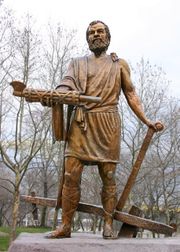For the previous entry in this series, click here.
Hoping to recoup his fortunes in the wake of the Roanoke fiasco, Sir Walter Raleigh in the 1590s decided to embark on a new American venture: searching for El Dorado. The Spanish had undertaken two unsuccessful expeditions to find the fabled city (more precisely, man) of gold – one of which is chronicled in this film – but Raleigh, who probably heard of El Dorado from Spaniards captured by English privateers, thought he could succeed where Pizarro and Aguirre had failed.
Raleigh believed that El Dorado could most likely be found on the Orinoco River in present-day Guiana, and in 1594 he sent a ship to explore the Guianan coast and gather intelligence. The vessel returned the following year with its logs, charts, and four Indian passengers, two from Guiana and two from Trinidad. Thomas Hariot set to work teaching the new visitors the English language and interrogating them about Guiana's geography, wildlife, and people. At least one of these translators accompanied Raleigh when he embarked for Guiana later that year.
Raleigh's 1595 Guiana expedition was short but (from our standpoint) consequential. After pausing to defeat the Spanish garrison on Trinidad, the adventurer and his 100 or so companions ascended the Orinoco River into present-day Venezuela, and made an alliance with Topiawari, the cacique (chief) of the Arromaia Indians. To seal the pact, Raleigh left behind two Englishmen to learn the Arromaian language, and took with him to England Topiawari's 19-year-old son, Cayowaroco, and 3-4 other South American Indians (from Guiana and Trinidad), to instruct them in the English language.
Two of the Native Americans from the 1594-95 expeditions, whom Raleigh and his associates renamed John Prevost and Henry, returned to Guiana in 1596 and 1597 with the English navigators Lawrence Keymis and Leonard Berry. These translators helped their captains establish diplomatic relations with other Guianan caciques, and by the early 17th century England had established a commercial presence on the northeast coast of South America. (Source: Alden Vaughan, "Sir Walter Raleigh's Indian Interpreters," pp. 358-365; see also Charles Nicholl, The Creature in the Map: A Journey to El Dorado [Chicago: University of Chicago Press, 1997.)
For the next entry in this series, click here.
Sunday, January 21, 2007
Monday, January 08, 2007
Returning to His Plow

The recent death of Gerald Ford has caused me to reflect on the awkwardness of presidential retirement in the United States. Monarchies, or nations whose chiefs of state serve for life, don't have to consider how they will treat former chief executives. Other republics (like ancient Rome or modern Chile) provided ex-consuls or ex-presidents with lifetime appointment to their senate, thus giving them a place of honor and influence commensurate with their former power. Americans, however, expect their presidents to go home and die quietly after they finish their terms of office.
This is largely the fault of George Washington, who, following the example of Lucius Quinctius Cincinnatus (fl. 5th century BCE), voluntarily relinquished supreme command not once but twice. In 1783 General Washington, then commander-in-chief of a victorious revolutionary army, surrendered his sword to the Continental Congress - then a rather scruffy and fugitive assembly - and retired to his plantation in Virginia. This first retirement so impressed American electors that they unanimously chose Washington to be the first president of the national government, knowing he could be trusted to walk away from power. Moreover, as president Washington refused to serve more than two terms, even though he could have served as many as he wanted (the Constitution did not impose presidential term limits prior to the 22nd Amendment). He thereby established a precedent that only a few of his successors had the nerve to try to break.
Washington retired from the presidency in 1797, went back to Mount Vernon, and died less than three years later. His successors, however, were only rarely able to contrive so fitting an end to their public service. Of 41 past American presidents, 8 died in office (W.H. Harrison, Taylor, Lincoln, Garfield, McKinley, Harding, F.D. Roosevelt, and Kennedy) and 6 lived less than five years after retiring (Washington, Polk, Arthur, Wilson, Coolidge, and L.B. Johnson). The remaining 27 lived for an embarrassingly long time, which most spent writing their very dull memoirs and making money.
Has anyone had a memorable post-presidential career in the United States? Only a few examples come to mind:
* Thomas Jefferson, who helped found the University of Virginia;
* John Quincy Adams, who served in the House of Representatives for 17 years, fought against slavery, and played a major role in the founding of the Smithsonian Institution;
* William Howard Taft, who served as Chief Justice of the U.S. Supreme Court (1921-30), the only position in the federal government co-equal to the presidency;
* Herbert Hoover, who served as a government commissioner in Germany after World War Two and helped set up emergency food programs there;
* Jimmy Carter, who served as an international election monitor, helped (and still helps) raise millions of dollars to fight tropical diseases, and won the Nobel Peace Prize.
Ford, by contrast, appears to have done approximately nothing in retirement, except make money, go to church, and play golf. In his defense, one can merely say that he was following Washington's example, in his own humble way. And one can also say that Ford's retirement years were not an embarrassment to the nation - unlike those of Franklin Pierce, who after leaving the White House became a supporter of the Confederacy, ran over an old woman with his carriage, and purportedly said "there's nothing left to do but get drunk."
Subscribe to:
Posts (Atom)
